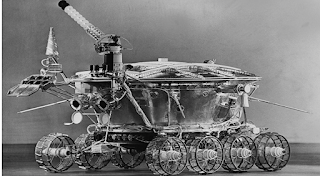Over the years, research has been done to explore space beyond Earth, and we have succeeded in developing the necessary information and technology, but sometimes we succeed and sometimes we fail.
Happily, the technology has evolved so much day by day that it has begun to help us find lost things in the past.We are well acquainted with the scene where the family finally finds the Ivalya mark on the hero's pen, lost as a child. Meanwhile, before that, the hero is fighting with thousands of thugs, in which the sleeves of his shirt are torn and the separated ones come together.
Something similar has happened in the case of Russia and its spacecraft. The spacecraft has been successfully discovered by NASA scientists after fighting with a photo of the moon in literally thousands.The spacecraft was launched into space about 37 years ago but lost contact with it over time, and has since been found by NASA.
Using lunar photographs published by NASA with the help of its lunar map, the mystery of the 37-year-old space has been unraveled.
Let's see how.
The protagonist of this story is Professor Cross Phil Stuck, who works in the Western Departments of Physics and Astronomy and Geography. Stuck published a reference book on lunar research in 2007 entitled "International Atlas of Lunar Research".
On March 15, images and data from NASA's Orbiter (LRO) were posted.
Which will create an internal map for a one-year search expedition 31 miles above the lunar surface, search for resources and help find a potentially safe landing site, as well as measure the lunar temperature and rays.
After scrambling for NASA's Atlas and thousands of photographs on the moon, Stuck discovered the exact location of the Russian rover Lunokhode 2.
To track the 35-kilometer track left on the moon by the spacecraft 37 years ago, he trekked 35 kilometers with the help of a lunar map and with his help tracked other tracks.
The journey was the longest for any robotic rover to reach the second celestial body to date.
Soon after the publication of these important photographs, Stuck and other scientists from around the world began their search for the Harvard. Stuke created a database of photos that should be easy to find, and he eventually found the photo he wanted out of the thousands of photos he wanted.
Launched in 1970, NASA's state-of-the-art Lunar Reconnaissance Orbiter (LRO) played a key role in the discovery of the spacecraft.
Mark Robinson, chief investigator of the Arizona State University's Lunar Reconnaissance Orbiter Camera, says the LRO technology is a boon to the moon. The camera mounted in it is capable of capturing and sending more accurate and clear photographs.
The Lunokhods, launched by the Soviet Union, was one of the first eight-wheeled rovers launched in the early 1970's.
The rover was powered by solar energy during the day and was fitted with a heat radiator to run at night as the temperature on the moon dropped at night.This rover was built to collect soil samples from the moon.
So during their mission, the spacecraft landed on the moon to collect samples, so they walked in a small cupboard to take a sample of the soil and for some reason got stuck there. Then by accident, its heat was buried under the radiator.
There was nothing that he did to cause it. Eventually it got even hotter and at one point he stopped working. After a while, the spacecraft began to look like a spot on the moon.
Its tracks were visible where the vehicle landed. The mission of the spacecraft was well studied by Stuck, and modern technology made it easier to get a glimpse of the work done by the rover and to explore the magnetic field along the same path to get more accurate information.
According to Stuck, the discovery now requires a change in the shadow images of the map circulated by Russia to include a modified photo.
Stuck says NASA scientists have used their atlas data systematically for both creation and data recovery. His next project is on Mars and this project is similar to the best maps of both the Moon and Mars.









0 comments: